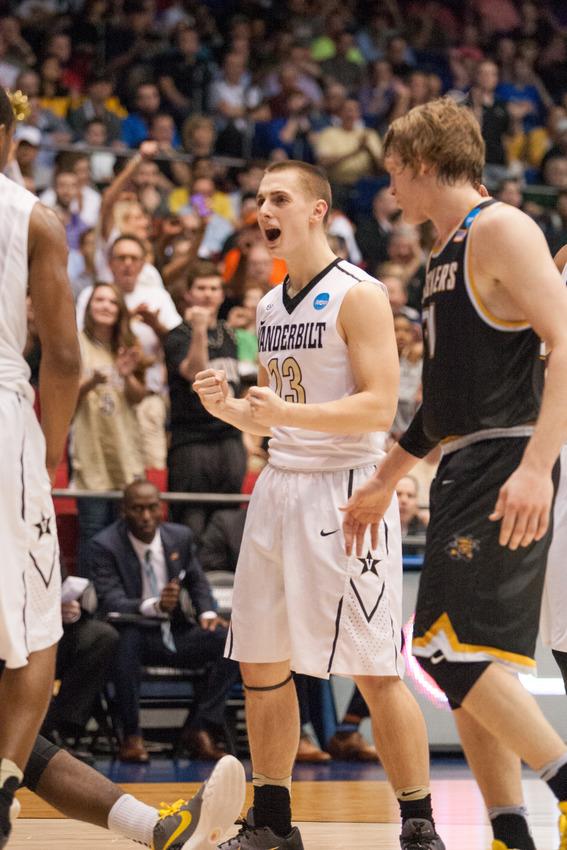When Riley LaChance burst onto the scene in 2014, the Commodores thought they had something truly special.
The all-state guard from Brookfield, Wisconsin, wasn’t expected to make a big impact early, but he ended up starting all 35 games, leading the team in minutes in the process. Just eight games into his freshman campaign, LaChance dropped 26 points in a win over Purdue, following it up with 26 more a few days later against Western Carolina. LaChance finished the year with a nod to the All-SEC freshman team, and what at first seemed like a savvy recruiting move by former coach Kevin Stallings looked more and more genius every week.
Fast forward to the 2015-16 season and you’ll find LaChance starting on the bench, playing a minimal role in the offense and struggling to hit shots. In the last 15 games of the regular season, LaChance never scored double-digit points and failed to hit a field goal on seven of those occasions.
So what happened in a year? How did a star freshman leader become a non-scoring option on the bench in just 12 months?
Well, there isn’t one clear answer, and the dip in numbers from LaChance was something that caught many off guard. One could say that the rise of Wade Baldwin IV made LaChance a secondary option, but that still doesn’t explain his dip in performance. With Baldwin leaving for the NBA, LaChance has the spotlight once again and will have to work to regain the role he lost.
This year’s Vanderbilt team doesn’t have the same star power as last year’s. But it does have veteran presence on its side, and LaChance is one of those veterans. Coming into his junior year off a less than expected sophomore campaign, LaChance looks to rebound and be a mentor for the younger guys.
“I try to be a leader in the locker room,” LaChance said. “I think a lot of guys look at me to step up and lead, but it’s not just one guy. We need a lot of guys to lead.”
Those other guys are Matthew Fisher-Davis and Jeff Roberson, who lead a strong junior class, along with Luke Kornet, the team’s only projected senior starter. Kornet is also the only big man with any in-game experience, and with the prospect of Roberson and sophomore forward Joe Toye playing power forward often, fans will see a lot of LaChance at both the point and shooting guard spots.
“He’ll do both,” head coach Bryce Drew said. “He’ll play with the ball and without the ball, and guys are interchangeable. Numbers don’t really matter once we get in our offense.”
The idea of position-less basketball is one that should favor LaChance, as he’s thrived more in off-ball situations, something he experienced often in his freshman season.
LaChance has always been a solid passer, but his main weapon has been his ability to score in the half-court, whether it’s via the three-ball or in the lane. As a senior at Brookfield Central High School, LaChance shot 50.8 percent from the floor and 48.6 percent from three. The expectation was that he could be a lethal shooter that could give Vanderbilt a scoring boost.
In his freshman year, he shot only 38 percent from three but hit big shots in big moments, and what he didn’t do from deep, he made up for in the paint. LaChance is only 6’2”, but he showed the ability to attack the rim and score over bigger defenders. He shot 44 percent from the field and had the confidence to score from anywhere on the floor, including the free-throw line, where he shot 87 percent on the year.
His sophomore season, he watched that 44 percent dip to 35 percent. The 87 percent from the line dipped to 77 percent, and his 12.3 points per game average was almost halved, as he finished the season with 6.9. He also saw his minutes decrease significantly, from 33.3 per game to 24.8.
A large part of this dip in the numbers seemed to stem from a lack of confidence. LaChance simply didn’t take the ball inside as often as he did in his freshman year. Instead, he settled for midrange jumpers, which significantly affected his field goal percentage, as his two-point field goal percentage dipped from 49 percent to 35 percent. He started passing up opportunities for high-percentage shots and chances to get to the free-throw line, as he attempted 43 fewer free throws in his sophomore season.
LaChance simply wasn’t playing with the same speed or the same sense of urgency. When his shot wasn’t falling, he would abandon it entirely, which is why he ended up with so many games with no field goals.
Make no mistake about it, LaChance is first and foremost a shooter. His confidence starts from his jump shot, and if he’s hitting his shots, his offensive repertoire seems to expand. He’ll have the opportunity to do that more often this year playing off the ball, as freshman guard Payton Willis will assume some of the point guard duties. Under Drew, LaChance’s approach may change as well.
“He is extremely detailed,” LaChance said of his new coach. “Everything is very intense and very up-tempo.”
Vanderbilt doesn’t have the athletes it’s had in the past to create off the dribble, but Drew’s up-tempo offense will look to promote more run-outs and ideally get LaChance the ball for more in-close scoring opportunities.
If he can hit shots and score from all areas of the floor like he did two years ago, he’ll be able to give that spark that the Commodores are missing without Baldwin. And if he starts to hit threes like he’s shown he can, along with the shooting ability of Fisher-Davis, Roberson, Willis, Toye and even Kornet, Vanderbilt can be a nightmare offensively.
“We have some excellent shooters,” says Drew. “That’ll be a big part of our season, our ability to make three-point shots.”



